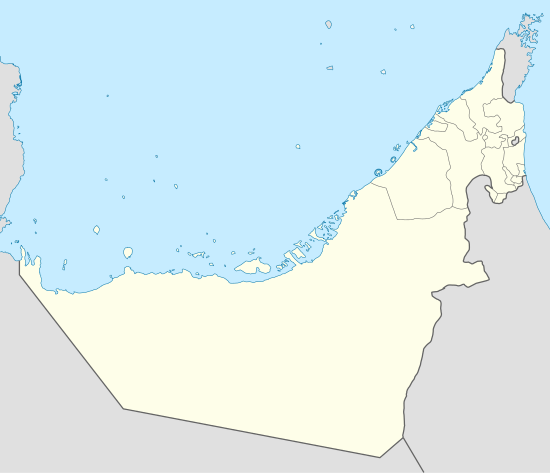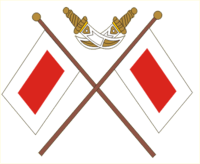Rams (Ras Al Khaimah)
Rams is a suburb of Ras Al Khaimah in the United Arab Emirates (UAE).[1] Once a pearl diving and fishing community which frequently disputed the rule of Ras Al Khaimah, today it forms the northern coastal settlement of the city.
Rams | |
|---|---|
 Rams | |
| Coordinates: 25°52′44″N 56°1′25″E | |
| Country | United Arab Emirates |
| Emirate | Ras Al Khaimah |
| Area | |
| • Total | 8 km2 (3 sq mi) |
| Elevation | 144 m (475 ft) |
| Population | |
| • Total | 13,000 |
History
A coastal community, Rams' hinterland consists of palm groves and the Dhayah fort. It was at Rams that the British punitive expedition landed in 1819, following the sack of Ras Al Khaimah. The British fought their way inland to Dhayah, where they encountered spirited resistance, finally taking the surrender of almost 800 men, women and children after bombarding the hill fort there. The General Maritime Treaty of 1820 was signed by Hassan bin Ali, 'Sheikh of Zyah' who was, in fact, the Sheikh of Rams and Dhayah.[2]
Rams was traditionally home to the Tanaij tribe, all 400 houses there were settled by the early 19th century by that tribe.[3] Almost a hundred years later, the village had a single shop, kept by a Persian gentleman, and some 7,000 date palms.[2] The inland area of Dhayah was by then uninhabited, having been sacked by the British in 1819.[2]
They mostly relied on pearl fishing, with a fleet of 3 pearl boats and 10 fishing boats.[4] The Tanaij of Rams would frequently hire members of the unruly mountain Shihuh tribe for pearling expeditions.[5] Themselves unruly subjects, Rams frequently came into conflict with the Rulers of Ras Al Khaimah.[6]
It has a long, 1.6 km beach, which has in recent year witnessed a number of ecological disasters, including a mass death event where thousands of dead fish, thought to be sardines, were washed up on the beach in May 2018.[7] Earlier in the year, a 9-meter whale was washed up.[8]
With its long history of pearl fishing, many of the older buildings in Rams (constructed from wood, coral and local materials) are being considered for redevelopment.[9]
References
- "Al Rams Corniche - Seaside - Ras Al Khaimah". en.rasalkhaimah.ae. Retrieved 2018-09-12.
- Lorimer, John (1915). Gazetteer of the Persian Gulf, Vol II. British Government, Bombay. p. 1573.
- Arabian Gulf Intelligence. Cambridge: Oleander Press. 1985. p. 14. ISBN 9781909349964.
- Heard-Bey, Frauke (2005). From Trucial States to United Arab Emirates : a society in transition. London: Motivate. p. 75. ISBN 1860631673. OCLC 64689681.
- Heard-Bey, Frauke (2005). From Trucial States to United Arab Emirates : a society in transition. London: Motivate. p. 78. ISBN 1860631673. OCLC 64689681.
- Heard-Bey, Frauke (2005). From Trucial States to United Arab Emirates : a society in transition. London: Motivate. p. 298. ISBN 1860631673. OCLC 64689681.
- Reporter, Aghaddir Ali, Staff (2018-05-07). "Thousands of dead fish wash up on Ras Al Khaimah's Al Rams beach". GulfNews. Retrieved 2018-09-12.
- Shaaban, Ahmed. "Dead whale washes up on Ras Al Khaimah's shores". www.khaleejtimes.com. Retrieved 2018-09-12.
- "Al Rams: A community facing an uncertain future, by Antonie Robertson". The National. Retrieved 2018-09-12.
